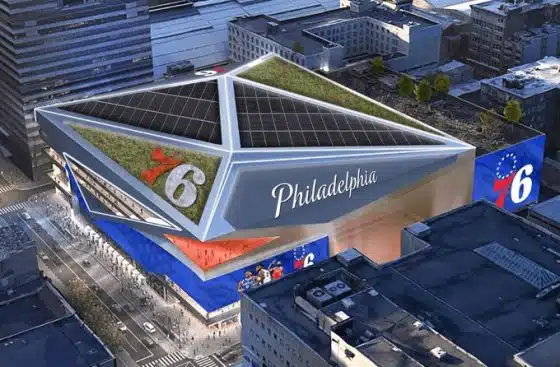NBA
Philadelphia City Council Cites Impact Studies On 76ers’ Proposed Arena

The City of Philadelphia has released four separate impact studies from CSL that analyze the proposed Philadelphia 76ers arena in Center City. The four reports include: a community impact assessment; an economic impact analysis; a design consulting; and a traffic, transportation, and parking analysis.
Philadelphia City Council’s community impact report focuses on two areas: Market East and Chinatown
Regarding community impact, the report focused on two areas: Market East and Chinatown. According to the study, the impact on Market East is “inconclusive” and with or without the arena, the area will still face challenges in terms of development.
However, the report also notes the development could help reinvigorate the neighborhood if it can resolve transportation and safety issues. The full 140-page impact studies document can be read here.
The impact study on the potential Sixers arena in Center City makes it pretty clear: Chinatown as we know it would be toast. https://t.co/2fg2s0uOsv pic.twitter.com/7TsLMT1Sjf
— Bradford Pearson (@BradfordPearson) August 27, 2024
As for Chinatown, the report says 1 in 5 small businesses in the neighborhood could benefit. Those businesses are mainly in entertainment, food, and hospitality.
Meanwhile, half of the small businesses in Chinatown would not benefit or see a negative impact. The report states there will be no direct housing displacement, but there is evidence for indirect displacement of small businesses, through gentrification.
Chinatown community is concerned about traffic; Philadelphia 76ers could offer incentives for people not to drive?
John Chin with the Philadelphia Chinatown Development Corporation spoke about where their organization stands on the arena. “I think this report really highlights a concern that this arena could threaten the sustainability of our Chinatown there,” he said.
Chin says traffic is another big concern for the Chinatown community. Of course, the study finds there could be traffic issues. If more than 40% of the attendees to the arena drive, there could be gridlock around the arena. The study also stated there is enough garage parking to meet the arena’s demand.
The Sixers-bankrolled impact studies on #76Place are here.
There are a lot of dubious numbers and projections in these studies, but the community impact study can’t hide the obvious: An arena would decimate Chinatown. #SaveChinatown pic.twitter.com/NqgPh2JYRp
— Save Chinatown Philly (@SaveChinatownPA) August 27, 2024
Moreover, the study indicates that the Sixers should offer incentives for people not to drive. One incentive is free transit passes with each ticket to help alleviate traffic congestion.
For the economic impact, the study says the arena could add 53 more ticketed events to Philadelphia. This includes other sporting events and concerts. It also could add $390 million in tax revenue to the city after 30 years of operation. The final part of the reports is about the design, which evaluated renderings released last year.
The design review team praised the design for allowing space for retail opportunities. Though, it’s also calling on the developers to create an open public space or plaza next to the site.
Philadelphia 76ers Development Corporation released a statement
The Philadelphia 76ers Development Corporation released the following statement about the reports:
“We are reviewing what has been released and we will have more to say when we are able to complete a full analysis, but it is clear already that they support what we’ve said since we first announced 76 Place: the arena is an appropriate use for Center City and will generate significant new jobs and tax revenue because Philadelphia can support two arenas. Our parking and traffic assumptions are achievable, and these findings are more evidence that 76 Place can be developed in a way that protects our neighbors and maximizes benefit to Philadelphia.”
The reports were not paid for by taxpayer dollars, the city added.
Nonetheless, payments were made from the 76ers, who the city said had no influence on the report. The Save Chinatown Coalition also released a statement on the arena impact studies.
“That the Sixers bankrolled these studies, and failed to disclose that fact from the jump, says everything you need to know about their credibility. The economic analysis was completed by a consultant with a track record of faulty data and false projections in Philadelphia,” said Vivian Chang, executive director of Asian Americans United and member of the Save Chinatown Coalition.
“The failure to calculate the financial cost of the arena to Chinatown, other neighborhoods, and existing businesses tells you how unserious and flawed this paperwork is. As we continue carefully reviewing these documents in the coming days, it is clear these are not the studies the community asked for or the city needs.”
Additionally, the Chinatown Coalition said there will be a rally on Sept. 7 at 1 p.m. at City Hall against the arena.
Academics who specialize in stadium and arena finance are saying the studies are flawed, useless, and misleading
Although the studies seem convincing, academics who specialize in stadium and arena finance are not impressed. Per a few experts, the research presented in the study is based on opinions, biases, and hidden agendas.
According to The Philadelphia Inquirer, J.C. Bradbury, an economist at Kennesaw State University, called the CSL report a “concocted PR document.” He also said the firm was “notorious for doing these for-hire projections for paying clients.”
“Economists have studied the economic impact of sports facilities for years,” Bradbury added. “They consistently find little to no economic effects because sports spending is largely just a reallocation of existing spending.”
Bradbury believes these economic impact studies are flawed and misleading. This is mainly because they assume spending related to the arena would not occur otherwise.
Another expert is saying that there’s nothing applicable in these types of studies.
“The study is completely useless,” said Geoffrey Propheter, a professor of public affairs at the University of Colorado-Denver and the author of Major League Sports and the Property Tax. “That’s not a commentary on if it’s done well or not. That’s just a commentary on economic impact studies.”
A common problem with economic impact studies is that the research findings do not compare the effects of projects to what would happen in alternative scenarios.










